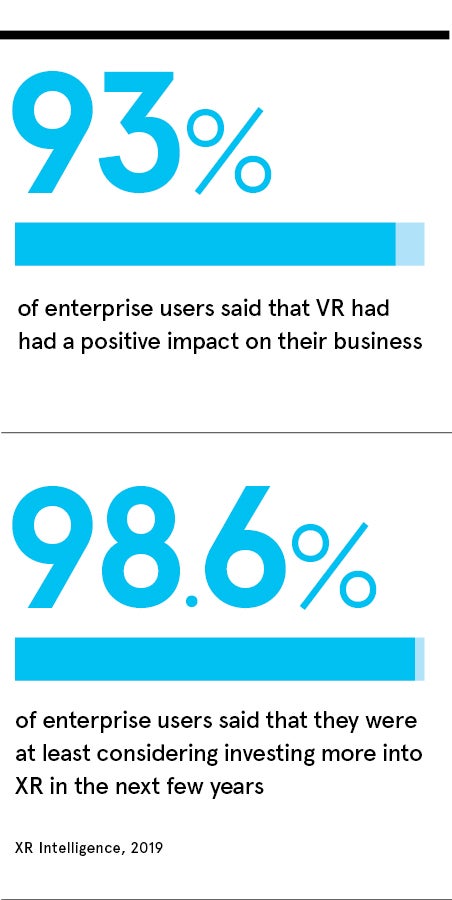Augmented reality (AR) has come a long way since it exploded into the mainstream in 2016 with the launch of Pokémon GO, which smashed mobile app download records and introduced many people to technology that overlays virtual interactivity onto real-life views of the world.
Since then, a growing number of companies have explored its viability as an effective business tool, along with its tech “cousins” mixed reality (MR), which not just overlays but anchors virtual objects to the real world, and virtual reality (VR), immersing users in a fully artificial digital environment.
Major enterprises around the world have begun exploring the ability of AR and MR, in particular, not just to boost customer engagement, which dominated early-use cases, but also to enhance the productivity, safety and capabilities of their industrial workforce.
Collaboration at distance becomes far more effective, particularly during periods like now when more people have to work from home
The impact of these technologies in production environments has enticed tech giants Microsoft, Amazon, Apple, Facebook and Google to enter the market, and analyst firm IDC anticipates worldwide spending on AR and VR will reach $160 billion in 2023, with notable investments in training ($8.5 billion) and industrial maintenance ($4.3 billion).
“Customer engagement has been a core driver of AR and MR investments because they’re a great way of telling a story as well as immersing a person in a product or brand,” says Paolo Capitelli, communities of practice director at Reply, which specialises in the design and implementation of solutions based on new communication channels and digital media.
“Product AR visualisation is especially powerful. There are great try-on tools for glasses, make-up and shoes, and IKEA customers have been able to see how furniture looks in their house for several years now. In the last 12 months, we’ve also seen intensive use of social apps that adopt photo filters over an augmented reality.
“However, in the age of Industry 4.0, MR and AR technologies are set to be even more transformative in optimising the daily processes of manufacturers and field workers. Though solutions in this area are still mainly in a proof-of-concept phase, their capabilities have taken several steps forward, allowing physical things such as plant or machinery to be augmented with digital information.
“This can be really beneficial in scenarios such as training employees to operate machinery, checking the real-time status of equipment or providing field workers with information that helps create a safer environment. Meanwhile, collaboration at distance becomes far more effective, particularly during periods like now when more people have to work from home.”
While the value on offer is potentially huge, numerous limitations have held enterprises back from embracing MR and AR technology quickly and at scale. They include the high cost of wearable devices, though prices are gradually coming down, a limited field of view on some headsets and lack of position accuracy in terms of millimetres, which is particularly challenging for manufacturing organisations.
As new innovations come on to the market, guidance has been lacking to help companies navigate the journey from initial AR and MR exploration to broad adoption, as well mastery of the tech and maximising return on investment across the broadest set of use-cases. Building applications from the hardware available can be costly because it still requires manual development and some devices are cumbersome or difficult to deploy in the field. 
However, these challenges are being addressed as the platforms and tools that allow companies to develop MR and AR applications become easier to use.
On the software development side, the number of tools is growing as well as the number of applications that enable even those with no development or 3D skills to implement MR and AR applications. On the hardware side, new technology capabilities, such as 5G networks and the possibility for remote rendering, is allowing MR and AR headset manufacturers to build devices that are lighter because most of the computation is in the cloud.
With ten years’ experience in MR, AR and VR, Reply supports companies in adopting these technologies by offering innovative solutions and services aimed at introducing greater efficiency in processes. The company guides organisations through the AR maturity model, beginning with the exploration and trial phase and then moving into deployment to solve business problems and establish operating models and governance frameworks.
Next, the AR strategy is connected to the broader enterprise IT ecosystem with multiple use-cases deployed and an organisation-wide operating structure for the technology is established, allowing processes to be reinvented, value to be measured and the new AR software platform to become available to the extended enterprise.
“It’s a continuously changing process and the technologies are evolving rapidly,” says Roberto Del Ponte, senior manager at Forge Reply, a specialist company within Reply focused on MR, AR and VR technologies.
“Reply is a trusted adviser to organisations looking to take advantage of these innovations. We prefer to test the technologies in our laboratories in Milan and Munich first. Some are discarded, some are adopted and only the best are presented to our clients. We can then help them understand where they can add value and which processes can benefit them the most.
“We are assisting companies in the identification of the right processes, selection of the right software and hardware technologies, and of course in the development of the applications themselves.
“It is important to start small and with the most effective use-cases. Once MR is adopted in a company, a wider range of ideas will actually be driven from the end-users. Investments in AR should also be part of a broader and structured process of digital transformation.
“Just like other technologies involved in digital transformation journeys, including the internet of things, big data, artificial intelligence and cloud, AR cannot be considered on its own. In fact, MR adoption is strictly linked to other digital transformation processes and should be considered within the wider enterprise digital transformation plan and investments.”
For more information please visit www.reply.com

